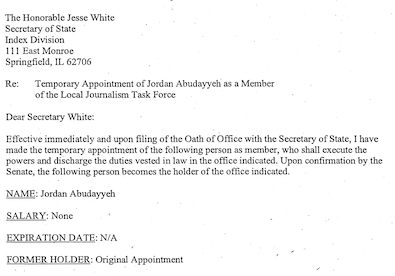* More background is here, but this is from August 24…
Governor JB Pritzker signed into law Senate Bill 134, which creates the Local Journalism Task Force. The Task Force will conduct a comprehensive study of the status of journalism and make recommendations for improvement to the Governor and General Assembly.
“Many communities across our country have become news deserts – through this legislation, Illinois is taking a step toward addressing that challenge,” said Governor JB Pritzker. “Robust local journalism is vitally important and I look forward to reviewing the recommendations from the Task Force as we seek to maintain and grow a strong press corps in Illinois.” […]
Senate Bill 134 creates the Local Journalism Task Force, which will:
• conduct a comprehensive study relative to communities underserved by local journalism in Illinois,
• review all aspects of local journalism including, but not limited to, the adequacy of press coverage of communities, print and digital business models for media outlets, the impact of social media on local news, strategies to improve local news access, and public policy solutions to improve the sustainability of local press business models and private and nonprofit solutions, and
• submit findings and recommendations to the Governor and General Assembly by January 1, 2023.
The Department of Commerce and Economic Opportunity will be required to provide administrative and other support to the Task Force. The Task Force is also required to meet a minimum of five times.
* Today…

She’s really wanted to be on that 15-member panel ever since the bill was passed.
* I asked Abudayyeh for comment…
As a former journalist, I care deeply about media literacy and ensuring the news industry remains viable amid our ever evolving media landscape. I look forward to working with the taskforce to identify ways to increase media coverage in underserved communities, so they do not have to rely on social media and political groups for their information. Our government functions best when communities are served by professional impartial news outlets that inform and educate their communities.
Thoughts?
44 Comments  
|
Question of the day
Thursday, Sep 2, 2021 - Posted by Rich Miller
* Letter from Rep. Mark Batinick, a Republican lawmaker who strongly encouraged Gov. JB Pritzker to impose a mask mandate last year. Emphasis was added by me…
Dear Governor Pritzker,
The pleasant exchange of letters between you and Leader Durkin ended with you requesting any ideas on how to help us move forward through this deadly pandemic. I have two ideas.
As you likely remember, I was the first state elected official to push for the use of face masks. Especially in adults, study after study has confirmed their effectiveness in combating the spread of COVID-19. And while some recent data showcases the limitations of masks in younger children, I do agree that there is a time and place for their use in schools.
However, let’s keep in mind that the science is not clear on how to handle this. The World Health Organization does not recommend masks for those under six years old ever, and only in areas of significant spread for those under twelve years old. There are downsides for younger children wearing masks. For example, social emotional learning is directly tied to facial expressions.
During mid-summer when the pandemic seemed to be waning, school boards were voting on mask mandates. My advice then and still is that any mandate should be tied to reasonable metrics that people from all sides can agree upon.
My first idea is to place metrics on the mask requirements. This means having the mandate go into effect when the positivity rate is above a certain point, and then having them automatically removed once they drop below a certain point. It will give communities hope and a goal, making it easier for citizens to understand what they are doing and why they are doing it.
My second idea is to localize the community spread metrics more. For instance, I live in Plainfield. Plainfield is partially in Will County and partially in Kendall County. The current Will County region (Region 7) touches the Indiana border, while the Kendall County region (Region 2) touches the Iowa border. Will County influences the spread of COVID-19 in the Kendall County portion of Region 2 more than a county that touches Iowa does.
I recommend making each county its own region, but calculating that county’s positivity rate from the county itself and any county that borders it. Regions will essentially overlap, creating a more accurate picture of community spread. By using this strategy, initial breakouts will be easier to quickly identify and mitigate. It will also allow for us to consider the use of counties in border states, which seem to have led to increased outbreaks in the past. I will also note it may be better for a large county like Cook County to be broken into two regions. This targeted approach will be more effective at detecting breakout areas early while also limiting mitigation requirements, which will increase compliance.
I look forward to your consideration of these ideas and your response.
Warmest Regards,
Mark Batinick
State Representative, District 97
I asked what he’d do about school districts which are in more than one county and he said the schools should be placed into the county with the most students.
* The Question: What do you think of Rep. Batinick’s two ideas? Make sure to explain your answer. Thanks.
32 Comments  
|
* Thank you, drive through…
More than a third of vaccinated workers reported anger at the transmission risk posed by their unvaccinated peers, according to a survey of more than 400 employees in late August by workplace consultancy Seyfarth at Work. About a quarter of non-inoculated employees said they’re upset at the growing restrictions against them.
Some workers are now hardening their stance, and “verbalizing gripes to one another and management,” the survey showed. To make their point, a group of unvaccinated employees at an engineering company has organized under the nickname of the “Vexcluded” to protest that they are being turned into outcasts, Philippe Weiss, president of Seyfarth at Work, said in the report. […]
The schism also shows up in disagreements about why the delta variant continues to spread. Four out of five of the vaccinated blame the unvaccinated for the number of rising cases, according to the results Tuesday from the Axios-Ipsos Coronavirus Index. Among the unvaccinated, only 10% thought they were at fault.
You made your choice. You’re endangering others who can’t be vaccinated and who are in danger of experiencing a breakthrough case. Deal with the consequences.
* From that aforementioned poll…
1. Concern with the pandemic continues to climb, with the Delta variant a pronounced cause of worry.
• Three in five Americans (60%) believe returning to their pre-coronavirus life right now would be a large or moderate risk, the highest level since early March.
• Three quarters (78%) of Americans are at least somewhat concerned about the COVID-19 outbreak at this time. Just as many (80%) are concerned about the Delta variant spreading in the U.S.
2. Opposition to getting the coronavirus vaccine has dropped to the lowest levels ever.
• Only one in five (20%) Americans say they are not likely to get the coronavirus vaccine, the lowest level since we started tracking. Hard opposition, those not at all likely, has dropped to 14% of adults.
• The number of parents who say they are likely to get their kids vaccinated has surged over the last week, now two-thirds (68%) report they are likely to vaccinate their kids or they already have. Opposition to vaccinating their kids has dropped to less than a third (31%) of parents.
[…]
4. American support of more vigorous anti-COVID policies continues to be strong, even as more Americans are experiencing them.
• Majorities of Americans continue to support policies requiring the use of masks in schools (70%) or public places (66%).
• Working Americans also continue to support vaccine requirements by their employer (57%).
• About one in five (19%) working Americans report that their employer currently requires vaccination but over half (54%) report masks being required in the workplace.
[…]
6. Vaccinated and unvaccinated America look in very different directions for the cause of the current surge in COVID cases.
• Four out of five (79%) of the vaccinated point to the unvaccinated as who they blame for rising cases. Beyond the unvaccinated, a third points to Donald Trump (36%), conservative media (33%), and people from other countries traveling to the United States (30%).
• Among the unvaccinated, there is not a single group pointed to as the main cause, especially not the unvaccinated (10%). Among the leading culprits are people traveling to the US (37%), Americans traveling abroad (23%), mainstream media (27%), and Joe Biden (21%).
The literal dead-enders are being overwhelmed by popular opinion…
“It’s amazing to me to see people I know that are really smart college-educated people that still believe some of the lies like it’s (vaccine) magnetized or whatever,” Kinzinger said. “The good news is the hesitancy is declining
* Crain’s…
Fans planning to attend Chicago Bulls or Blackhawks games, concerts or other events at the United Center will be required to show proof of COVID-19 vaccination or a negative test to get in, the arena announced today.
The new protocol for the Near West Side venue goes into effect immediately “and will remain in place until further notice,” the venue said in a statement, calling the decision “representative of the continued commitment to providing the best environment for a safe return for all fans and employees.” […]
The new rules amount to a highly effective way to safely host big indoor events, said infectious disease specialist Dr. Vishnu Chundi, chairman of the Chicago Medical Society’s COVID-19 task force.
“If you’re going to have an indoor event, this is the safest place to have (it)” with the new protocols in place, he said. He also noted the air turnover rate in the building—the pace at which air is changed out of a room—is faster than it is in many hospital operating rooms.”
* More…
* Covid Medical Bills Are About to Get Bigger: As some insurers focus on encouraging vaccination, temporary waivers that kept patient costs low are expiring.
* Champaign County’s transmission rates rising to pre-vaccine levels
* CDC releases report on The Crossing COVID-19 outbreak: Of concern were a 5-day overnight church camp for teenagers in Schuyler County and a 2-day men’s conference at The Crossing campus in Quincy. According to the CDC, neither COVID-19 vaccinations nor testing were required by The Crossing at either event. The report sets the total number of confirmed outbreak-associated cases at 180 as of August 13. Although the report suggests that number is likely much higher than investigators can confirm.
* Kids In Illinois Will Soon Be Able To Take 5 Mental Health Days From School
* Nearly 100 Quarantined After COVID ‘Outbreak’ Reported at Sycamore School, Supt. Says
* Chicago Teachers Union warns of ‘escalating actions’ if COVID-19 safety doesn’t improve in CPS schools, stops short of saying members might strike again
* Some CPS Parents Push to Obtain Remote Learning Waiver
* People with Delta Variant Can Transmit Virus 2 Days Before Having Symptoms: As a result, nearly three-quarters of infections with Delta happen during the presymptomatic phase, the research suggests.
* GM, Ford halt some production as chip shortage worsens: Industry analysts say the delta variant of the novel coronavirus has hit employees at chip factories in southeast Asia hard, forcing some plants to close.
* No one knows how many Chicago cops are vaccinated against Covid-19
* Police Say Demoralized Officers Are Quitting In Droves. Labor Data Says No.
* As COVID cases rise, vaccinations to resume at Peoria Civic Center
* Carle Health raises minimum wage to $15 an hour
43 Comments  
|
Unclear on the concept
Thursday, Sep 2, 2021 - Posted by Rich Miller
* Gov. JB Pritzker was asked today about outbreaks at schools…
Remember, an outbreak is one in which there are five or more kids or people at that school who have tested positive.
And then he insisted the criteria was “five or more” again after being pressed.
* Tribune…
The criteria for an outbreak was previously five or more cases but recently changed, said IDPH spokeswoman Melaney Arnold.
“Outbreaks at schools are two or more cases epidemiologically linked — people were in the same space at the same time,” Arnold said in a statement.
And if you go to the IDPH website, you’ll see that, of 26 outbreaks, 20 are classified as less than five cases.
…Adding… With thanks to a commenter, this is from the CDC…
Definitions for COVID-19 outbreaks are relative to the local context. A working definition of “outbreak” is recommended for planning investigations. A recommended definition is a situation that is consistent with either of two sets of criteria:
• During (and because of) a case investigation and contact tracing, two or more contacts are identified as having active COVID-19, regardless of their assigned priority.
OR
• Two or more patients with COVID-19 are discovered to be linked, and the linkage is established outside of a case investigation and contact tracing (e.g., two patients who received a diagnosis of COVID-19 are found to work in the same office, and only one or neither of the them was listed as a contact to the other).
14 Comments  
|
* After getting whacked by the courts during the 1981 remap process, the Democrats have always tried to appease Latino groups in the redistricting process to avoid another lawsuit. As we discussed yesterday, the new do-over maps passed this week have so far not dissuaded the Mexican American Legal Defense and Education Fund from moving ahead with its legal challenge. And now comes the Latino Policy Forum…
The Latino Policy Forum urges Governor Pritzker to veto the Illinois legislative maps passed by legislators this week, which do not equitably reflect the state’s Latino community.
Despite recent 2020 census data indicating that Illinois added 309,832 Latinos (the largest population increase among racial/ethnic groups statewide), no Latino-majority districts were added in the maps passed by the general assembly. In fact, preliminary analysis and reports show that some Latino-majority districts are diluted even more, further hindering the community’s ability to elect the representatives of their choice.
Furthermore, as with the maps from the spring, the Illinois legislature did not provide advocates with a reasonable timeline that would enable community input.
The Forum supports and stands alongside efforts led by the United Congress of Community and Religious Organizations (UCCRO), the IL Muslim Civic Coalition, the Chicago Lawyers’ Committee for Civil Rights, and other allies that denounce the passed maps.
…Adding… Leader Durkin…
Illinois House Republican Leader Jim Durkin (R-Western Springs) released the following statement on Governor Pritzker’s comments today about the new legislative maps:
“The Governor needs to live up to his campaign pledges for a fair map and veto another attempt by the legislative Democrats to silence communities across Illinois. The Governor does not just work for the Democratic insiders who got him elected. He needs to listen to the voices of groups like Latino Policy Forum and the IL Muslim Civic Coalition so that all Illinoisans feel that equity and inclusion are part of the mapmaking process.”
25 Comments  
|
|
Comments Off  
|
* Wall Street Journal…
States that ended enhanced federal unemployment benefits early have so far seen about the same job growth as states that continued offering the pandemic-related extra aid, according to a Wall Street Journal analysis and economists.
Several rounds of federal pandemic aid boosted the amount of unemployment payments, most recently by $300 a week, and extended them for as long as 18 months. The extra benefits are set to expire nationwide next week. But 25 states ended the financial enhancement over the summer, and most of them also moved to end other pandemic-specific unemployment programs such as benefits for gig and self-employed workers.
Nonfarm payrolls rose 1.33% in July from April in the 25 states that ended the benefits and 1.37% in the other 25 states and the District of Columbia, the Journal analysis of Labor Department data showed. The payroll figures are taken from a government survey of employers. The analysis compared July totals with April, before governors in May started announcing plans to end or reduce the benefits during the summer.
Economists who have conducted their own analyses of the government data say the rates of job growth in states that ended and states that maintained the benefits are, from a statistical perspective, about the same.
“If the question is, ‘Is UI the key thing that’s holding back the labor market recovery?’ The answer is no, definitely not, based on the available data,” said Peter Ganong, a University of Chicago economist, referring to unemployment insurance.
* Bar graph…

This is the second study we’ve covered on this topic. The other one is here.
Econ 101 has wrecked more peoples’ minds than anything else in higher education and has led to some pretty cruel policies.
*** UPDATE *** CBS 2…
The U.S. Department of Labor estimates 15,404 new unemployment claims were filed during the week of August 23 in Illinois, according to the DOL’s weekly claims report released Thursday. […]
Illinois’ estimated claims are among 340,000 total claims filed across the country last week. […]
There were 21,499 new unemployment claims filed during the week of August 2 in Illinois.
There were 20,019 new unemployment claims were filed during the week of July 26 in Illinois.
30 Comments  
|
Pritzker suffers rare veto override defeat
Thursday, Sep 2, 2021 - Posted by Rich Miller
* This doesn’t happen very often, so it’s one of those “man bites dog” stories…
The governor recently rejected a measure (HB684) that would allow private ambulance companies to bill non-emergency transports through the state rather than through managed care organizations contracted by Illinois to coordinate care for patients on Medicaid, the state’s health insurance program for the poor.
Pritzker contended the billing switch could harm vulnerable Medicaid patients, by making it harder for them to get ambulance rides to doctors’ appointments and other services.
First the House, then the Senate, easily and overwhelmingly overrode Pritzker’s veto.
The ambulance industry said managed care organizations are so far behind in reimbursing them for rides and they’re so financially stretched that they’re unable to pay emergency medical technicians enough money, contributing to a shortage of ambulance drivers and technicians.
* More…
The measure would transfer the review of claims from managed care organizations, or MCOs, which are private insurance companies that oversee most Medicaid services in the state. The Department of Healthcare and Family Services, which opposed the bill, would be the entity handling those claims under the bill. They already do so for emergency ambulance services, a change made in April.
The Illinois State Ambulance Association said the measure, House Bill 684, is needed to counter arbitrary denials of claims by private insurers. The governor’s office and HFS, however, expressed “serious concerns for patient safety and cost.”
In his veto message, Pritzker said the bill “has the potential to disrupt care and reduce the quality of provided medical transportation services to some of the most vulnerable Illinoisans.”
But ambulance services said payment delays from MCOs threatened staffing, and the change would simply provide a way to “get paid for the services provided.”
13 Comments  
|
Another day, another lawsuit
Thursday, Sep 2, 2021 - Posted by Rich Miller
* Tribune…
McHenry and Kankakee counties filed a federal lawsuit Wednesday challenging the legality of a state ban on jails housing federal immigrant detainees.
The lawsuit is a response to a law that Gov. J.B. Pritzker signed in August that calls for canceling contracts for jails to house immigrants awaiting court hearings and held by U.S. Immigration and Customs Enforcement, or ICE.
Kankakee, McHenry, and Pulaski counties have such agreements and keep about 260 detainees on average, ICE said.
“While perhaps proceeding from good intentions, this symbolic law does nothing other than serve as a demonstration of discontent by those in Springfield with current federal immigration policies and will only harm the very immigrants it purports to help,” McHenry County State’s Attorney Patrick Kenneally said in a news release.
* The lawsuit has three counts: Impairment of contract; Violation of intergovernmental immunity; Federal preemption of inconsistent state law.
5 Comments  
|
* Daily Herald…
People living in the suburbs make up 44% of the state’s population, but in August they accounted for just 26% of COVID-19 deaths in Illinois.
That’s the suburbs’ smallest portion of COVID-19 deaths for any month since the pandemic began, according to a Daily Herald analysis of Illinois Department of Public Health records. […]
People living in 96 counties outside the Chicago metropolitan area make up 34.5% of the population and have experienced 36% of deaths.
But that share is increasing.
More than half the state’s COVID-19 deaths in both July and August were from the 96 downstate counties, where less than 40% of the population is vaccinated against COVID-19. That compares to 53% that are vaccinated in the state as a whole.
* And southern Illinois is getting hit hard by people who won’t get themselves and their families vaccinated…
A Tribune analysis of state data shows that southern Illinois’ rate of hospitalizations is nearly as high as it was at its peak last fall: a rate of nearly 41 per 100,000 residents, compared with a rate of 43 just after Thanksgiving.
Its hospitalization rate is by far the highest in Illinois, and more than triple the rate in the city of Chicago.
About 37% of southern Illinois residents are fully vaccinated, compared with nearly 54% in Chicago. […]
Across the region’s 22 hospitals, many are delaying elective surgeries and keeping patients in beds in their emergency departments while they wait for other beds to become available, said Arien Herrmann, regional hospital coordinating center manager for region five, which encompasses the southernmost part of Illinois.
* The Southern…
Memorial Hospital of Carbondale has 22 COVID-19 patients in critical care and all of them are on ventilators. The youngest is 28 years old, SIH said.
Three of the patients have been fully vaccinated and are over age 65. Harre said most of those 22 patients in critical care are in their 20s, 30s or 40s.
“The Delta Variant is really hitting the younger population,” [SIH Chief Nursing Officer Jennifer Harre] said. “Once they go on a ventilator, it is really hard to get off the vent.”
With the original COVID-19 virus, most of the patients in ICU at the hospitals were from congregate living situations or over age 65.
* Meanwhile, in Chicago…
Chicago Public Health Commissioner Dr. Allison Arwady said the mask mandate that has been in effect for a little over a week is already resulting in positive COVID data for the city.
“We’re doing quite well in Chicago. We’re averaging 473 cases per day,” essentially the same as the daily rate a week ago. Chicago’s daily case rate per 100,000 people stands at 17.5—half the national rate of 39 people per 100,000 per day.
“What I’m pleased about is we’re seeing some real flattening here, I think that is largely a result, actually, of putting the masks back on indoors,” Arwady said. […]
The positivity rate is similarly flat at 4.4%. “We’ve actually not yet gone over 5%, that’s a very good sign, it shows us we’re testing well,” Arwady continued. The average daily hospitalization rate is 22—down 29% from the prior week.
Get your shots and wear your mask.
…Adding… Dr. Tracey Smith at the Illinois Public Health Association…
Hi Rich,
We saw your post this morning about the ongoing situation in southern Illinois. Below is a statement that should be attributed to Dr. Tracey Smith, director of Community Health and Programs at the Illinois Public Health Association:
As you alluded to this morning, there are people throughout Illinois grappling with some very dire situations. Community Health Workers have been on-the-ground for months doing all they can to slow the spread of COVID-19. This includes helping people in isolation and quarantine who might otherwise be disconnected from critical services.
The state’s Pandemic Health Navigator Program, which is managed by the Illinois Public Health Association and funded by IDPH, is still available to anyone who needs help finding basic human needs, such as:
• Getting meals and medications
• Mobility and mental health support
• Safer living conditions
• Work and income resources
Your readers could help their constituents by sending them to helpguidethrive.org. There they will find a directory of Community Based Organizations and Federally Qualified Health Centers throughout Illinois that provide these services and more.
* Related…
* A new study found half of hospitalized Covid patients had lingering symptoms one year later: “The need to understand and respond to long Covid is increasingly pressing,” said an editorial The Lancet published about the study. “Symptoms such as persistent fatigue, breathlessness, brain fog, and depression could debilitate many millions of people globally.” It added: “Long Covid is a modern medical challenge of the first order.”
* SIH officials say staff is stretched thin taking care of COVID patients
* Hospital data from southwest IL continues to show COVID impacts the unvaccinated hardest
* Petersburg PORTA cancels second straight game because of COVID-19 protocols
* IHSA has no policy for quarantine, exposure, or return to play for COVID-19: Troha said there have been 12 canceled games in week one and even one team, Urbana high school, that canceled their season altogether.
38 Comments  
|
|
 Support CapitolFax.com
Support CapitolFax.com
Visit our advertisers...
  ...............
...............
 ...............
...............
 ...............
...............
 ...............
...............


|
   
|
Hosted by MCS |
SUBSCRIBE to Capitol Fax |
Advertise Here |
Mobile Version |
Contact Rich Miller
|















